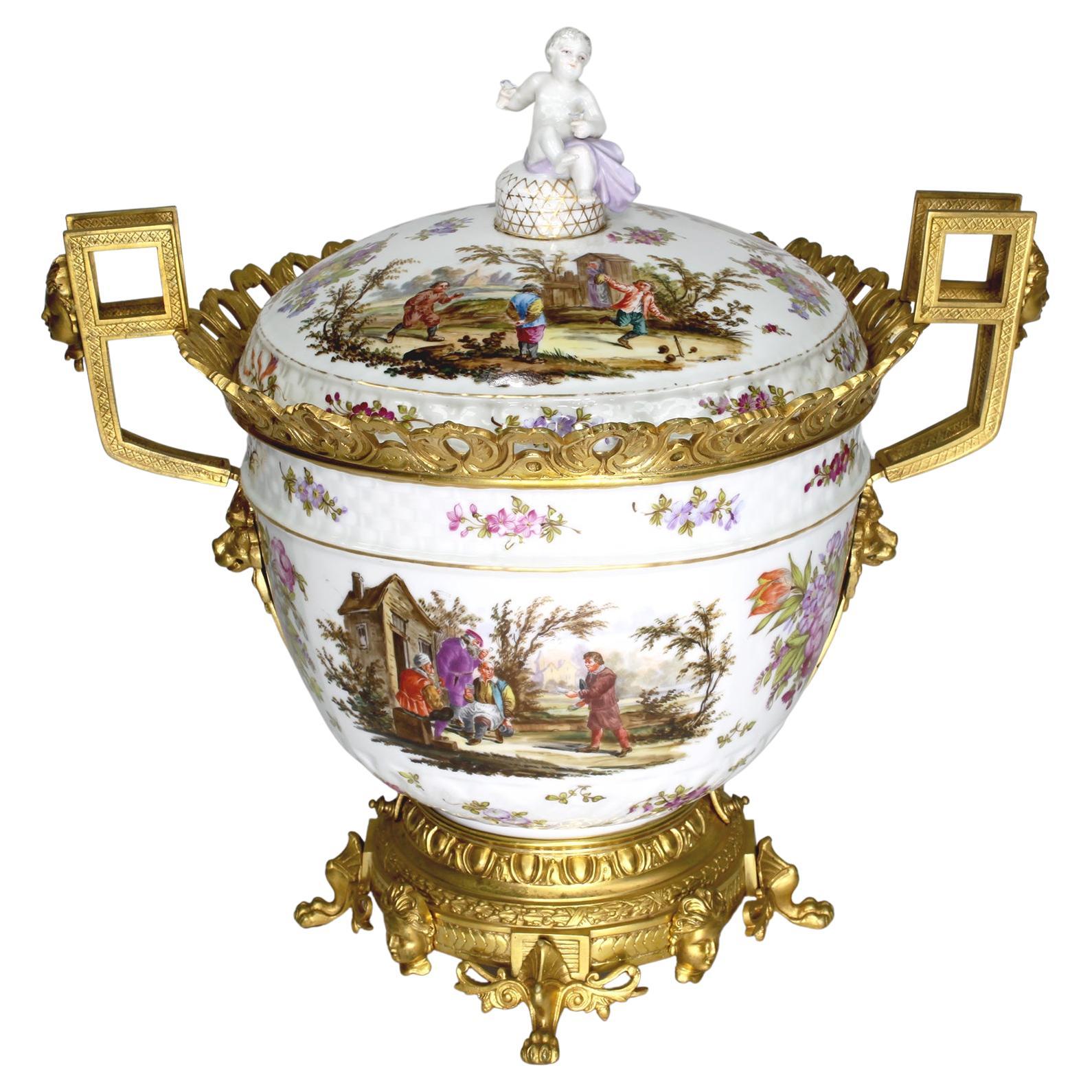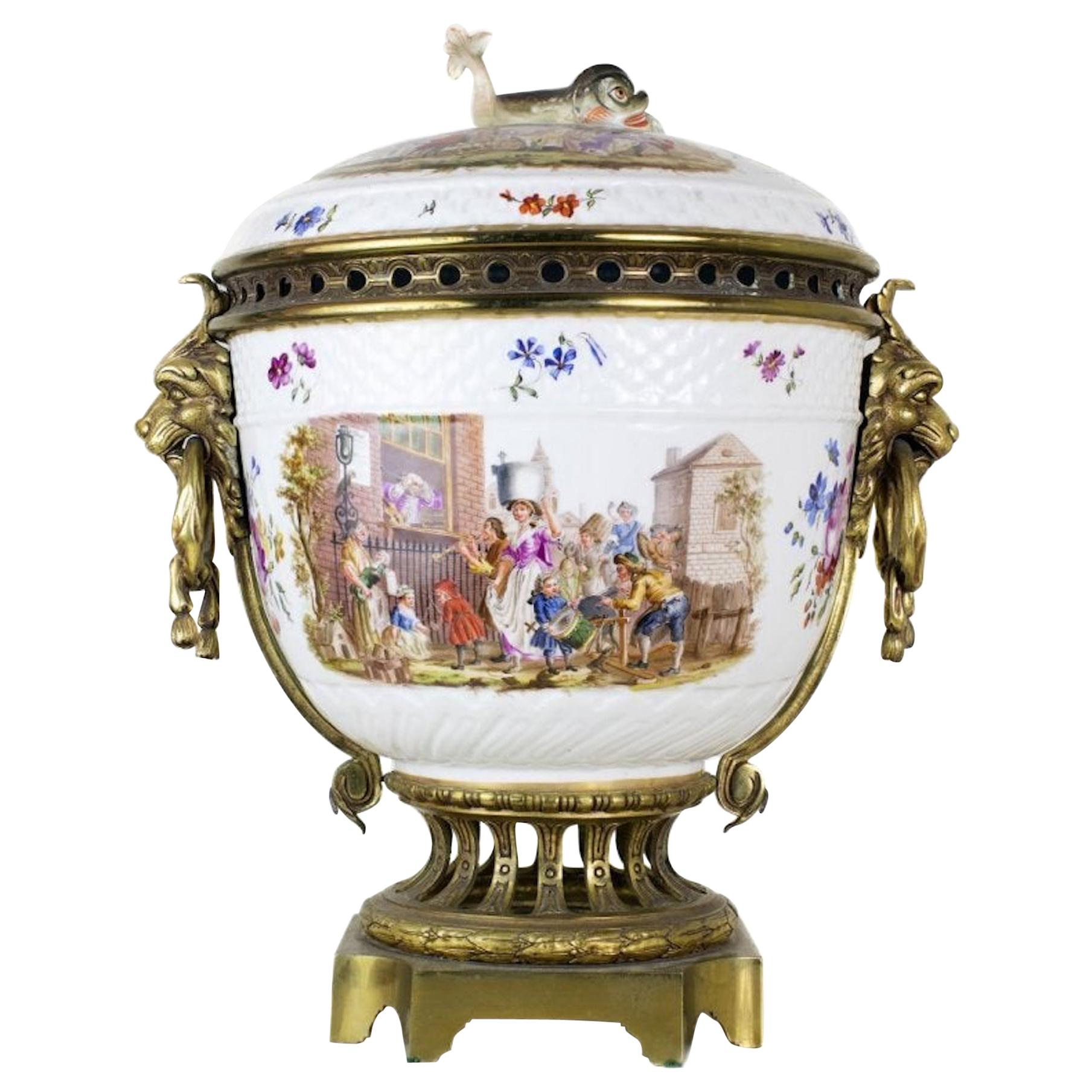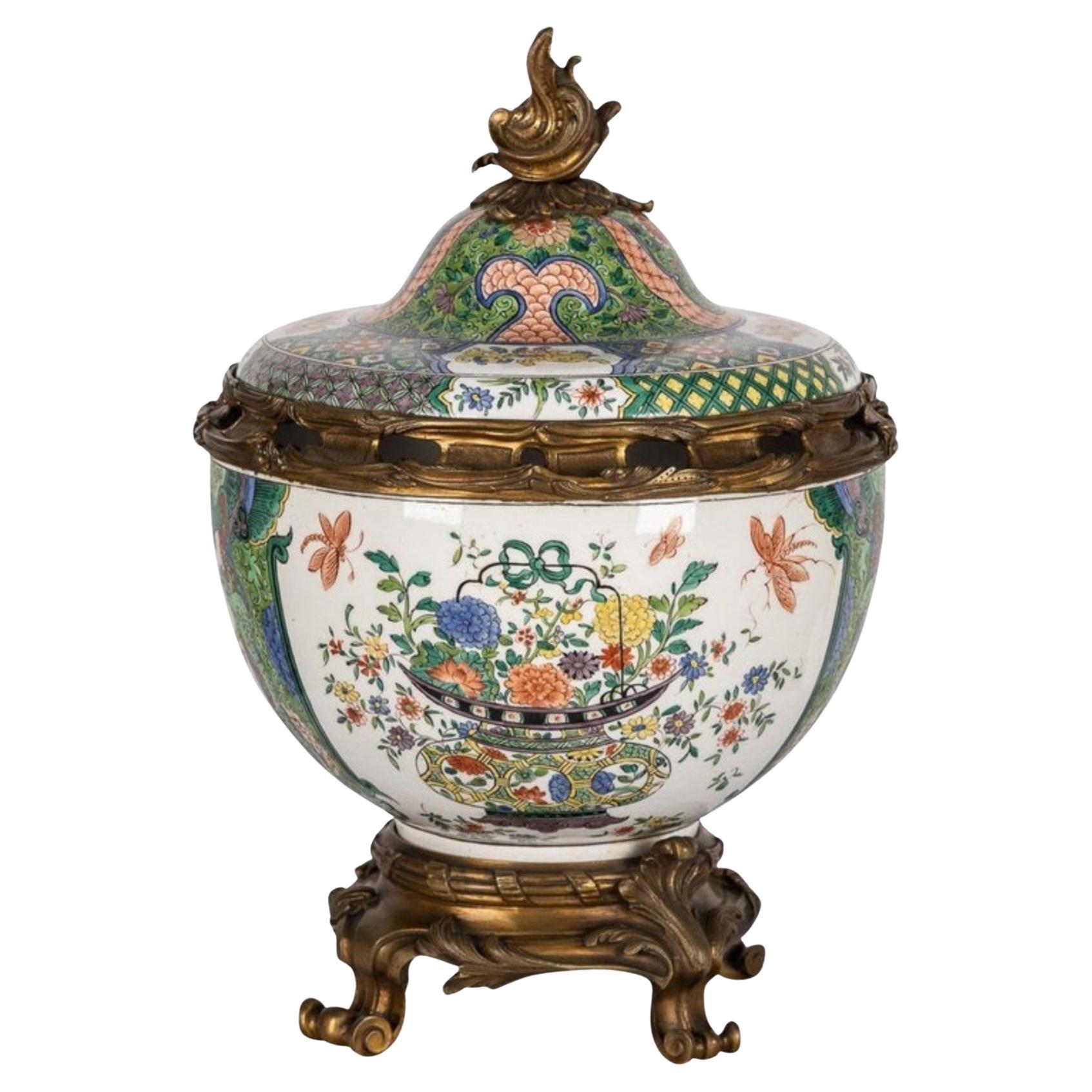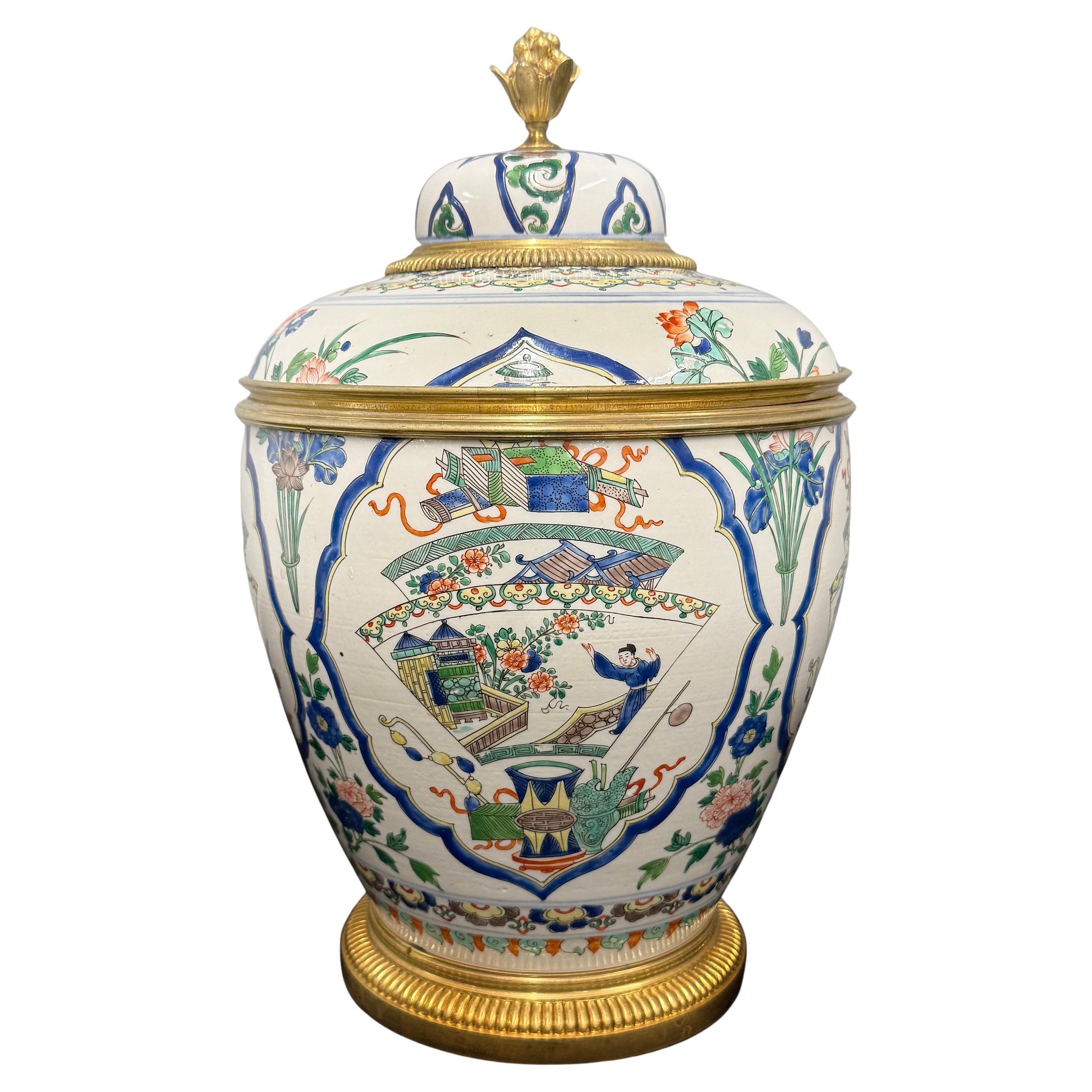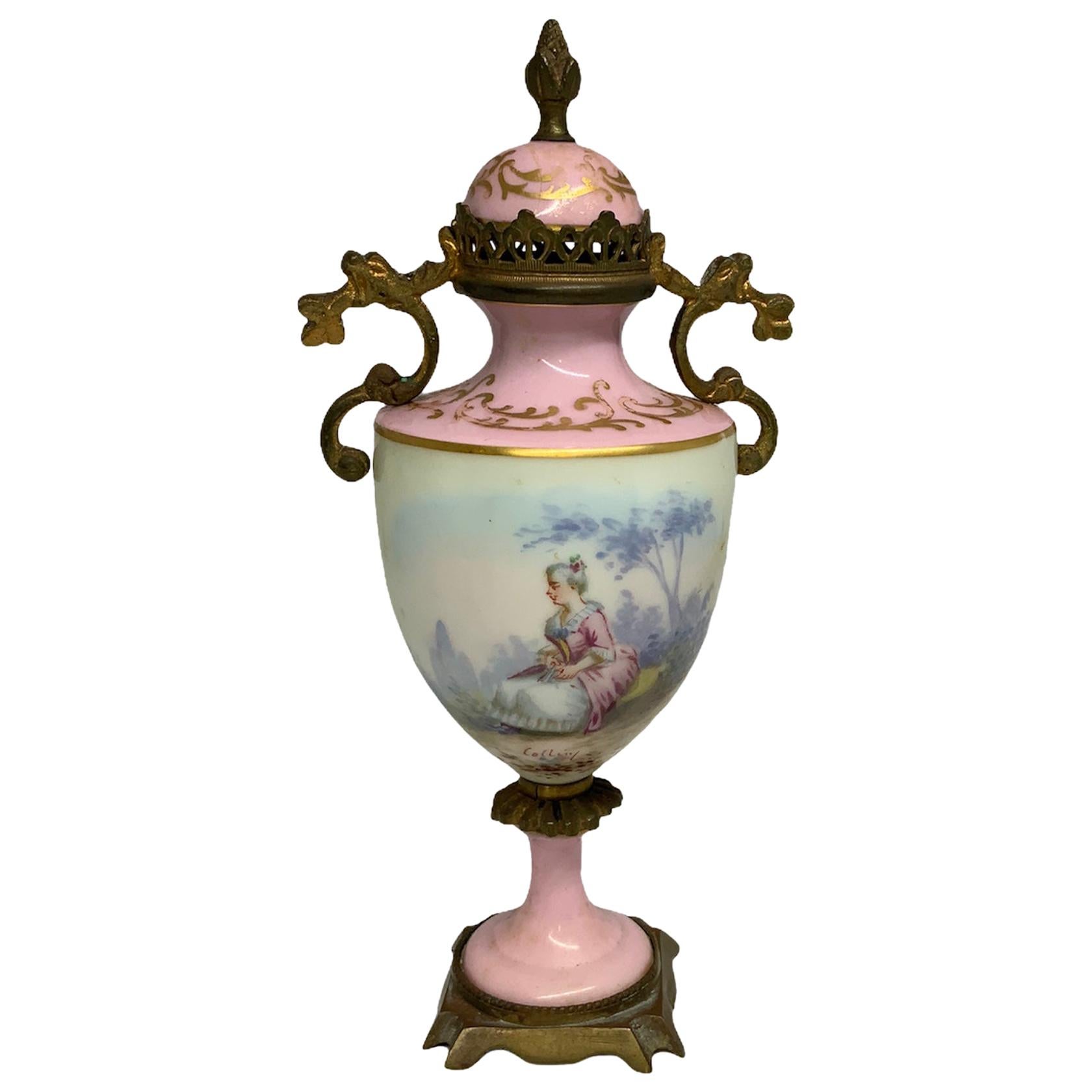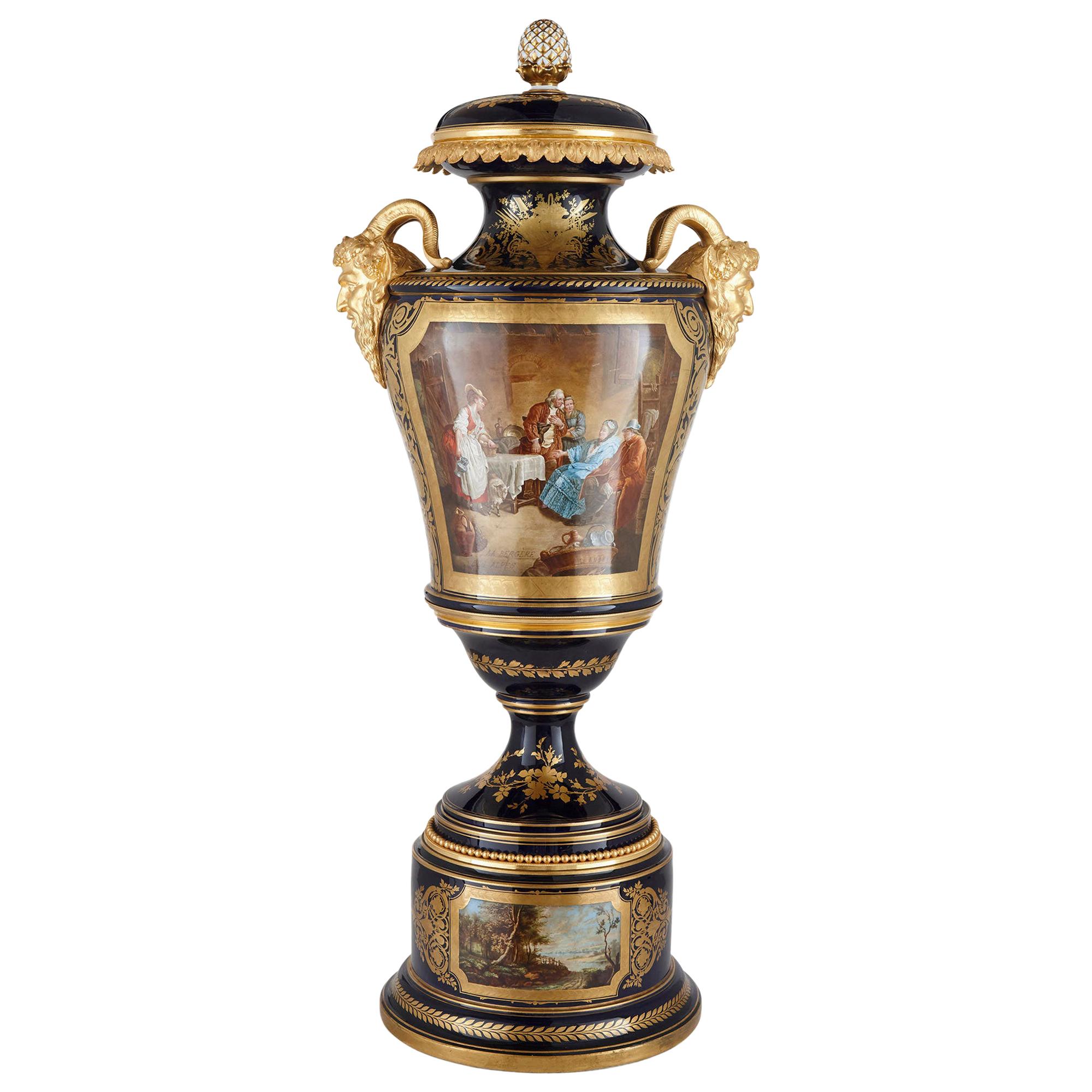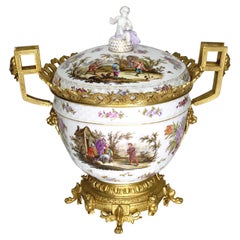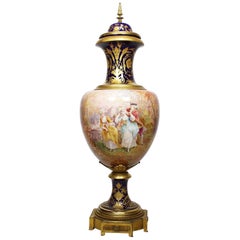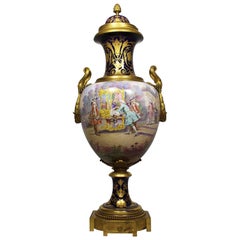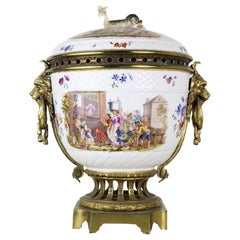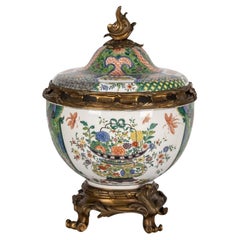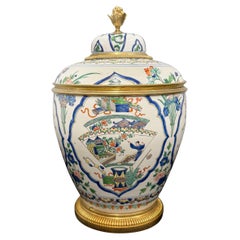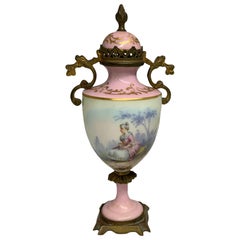Items Similar to Fine German 19th Century Porcelain and Gilt-Bronze Mounted Potpourri Urn Vase
Video Loading
Want more images or videos?
Request additional images or videos from the seller
1 of 18
Fine German 19th Century Porcelain and Gilt-Bronze Mounted Potpourri Urn Vase
$12,950
$18,95031% Off
£9,835.84
£14,392.9931% Off
€11,313.02
€16,554.5731% Off
CA$18,093.69
CA$26,476.8631% Off
A$20,176.51
A$29,524.7031% Off
CHF 10,527.24
CHF 15,404.7331% Off
MX$247,573.38
MX$362,279.1931% Off
NOK 133,995.03
NOK 196,077.6731% Off
SEK 126,957.38
SEK 185,779.3331% Off
DKK 84,433.25
DKK 123,552.9031% Off
Shipping
Retrieving quote...The 1stDibs Promise:
Authenticity Guarantee,
Money-Back Guarantee,
24-Hour Cancellation
About the Item
A very fine German 19th century porcelain and gilt-bronze mounted Potpourri Urn-Vase with Lid, attributed to Meissen. The ovoid white porcelain urn, decorated on all sides and lid with outdoor Country scenes of the hunting life, with peasants, horses, falcons, dogs, preys and flowers, all surmounted on an Imperial gilt-bronze plinth with lion-paw-feet and centered with a burning flame. The lid supported with an intricate pierced ormolu apron with a laurels and shield motif and twin branches, the top with an ormolu acorn with acanthus leaves. circa: 1880
Height: 26 1/4 inches (66.7 cm)
Diameter: 14 1/8 inches (35.9 cm)
Meissen Porcelain or Meissen china was the first European hard-paste porcelain. Early experiments were done in 1708 by Ehrenfried Walther von Tschirnhaus. After his death that October, Johann Friedrich Böttger continued von Tschirnhaus's work and brought this type of porcelain to the market, financed by Augustus the Strong, King of Poland and Elector of Saxony. The production of porcelain in the royal factory at Meissen, near Dresden, started in 1710 and attracted artists and artisans to establish, arguably, the most famous porcelain manufacturer known throughout the world. Its signature logo, the crossed swords, was introduced in 1720 to protect its production; the mark of the swords is reportedly one of the oldest trademarks in existence.
Dresden Porcelain (or "china") was once the usual term for these wares, until in 1975 the Oberlandesgericht (Higher Munich State Court) decided in favour of the Saxon Porcelain Manufactory Dresden, which alone was then allowed to use the name Dresden Porcelain (it ceased producing in 2020).
Meissen remained the dominant European porcelain factory, and the leader of stylistic innovation, until somewhat overtaken by the new styles introduced by the French Sèvres factory in the 1760s, but has remained a leading factory to the present day. Among the developments pioneered by Meissen are the porcelain figurines, and the introduction of European decorative styles to replace the imitation of Asian decoration of its earliest wares.
Since 1991, the manufactory has been operating as the Staatliche Porzellan-Manufaktur Meissen GmbH, whose owner is the Free State of Saxony. The company is one of the world's leading porcelain manufacturers and one of the oldest and most internationally known German luxury brands.
Beginning:
Chinese porcelain had gradually developed over centuries, and by the seventeenth century both Chinese and Japanese export porcelain were imported to Europe on a large scale by the Dutch East India Company and its equivalents in other countries. It was a very expensive product by the time it reached European customers, and represented wealth, importance and refined taste in Europe. European attempts to produce porcelain, such as the brief experiment that produced Medici porcelain in Florence, had met with failure.
At the beginning of the eighteenth century Johann Friedrich Böttger pretended he had solved the dream of the alchemists, to produce gold from worthless materials. When King Augustus II of Poland heard of it, he kept him in protective custody and requested him to produce gold. For years Johann Friedrich Böttger was unsuccessful in this effort.
At the same time, Ehrenfried Walther von Tschirnhaus, a mathematician and scientist, experimented with the manufacture of glass, trying to make porcelain as well. Crucially, his ingredients included kaolin, the vital ingredient of true porcelain, though he was unable to use it successfully. Tschirnhaus supervised Böttger and by 1707 Böttger reluctantly started to help in the experiments by Tschirnhaus.
When Tschirnhaus suddenly died, the recipe apparently was handed over to Böttger, who within one week announced to the King that he could make porcelain. Böttger refined the formula and with some Dutch co-workers, experienced in firing and painting tiles, the stage was set for the manufacturing of porcelain. In 1709, the King established the Royal-Polish and Electoral-Saxon Porcelain Manufactory (Königlich-Polnische und Kurfürstlich-Sächsische Porzellan-Manufaktur), placed Böttger's laboratory at Albrechtsburg castle in Meissen and production started officially in 1710.
Early Work:
The first type of ware produced by Böttger was a refined and extremely hard red stoneware known as "Böttger ware" in English (in German: Böttgersteinzeug). This copied Chinese Yixing ware, and like that was especially used for teapots, and now coffee pots. Similar wares had been made by the Dutch and the Elers brothers in England. Böttger's version was harder than any of these, and retained very crisp definition in its cast or applied ("sprigged") details, on bodies that could be polished to a gloss before firing. Models were derived from Baroque silver shapes and Chinese ceramic examples. There was also a softer stoneware, which was glazed and decorated. Meissen's production of a hard paste white porcelain that could be glazed and painted soon followed, and wares were put on the market in 1713.
Dish with Chinese scene and laub- und bandelwerk surrounds, 1720s
Böttger's experimental wares rapidly gained quality but never achieved successful painted and fired decor. The first successful ornaments were gold decorations applied upon the fired body and finely engraved before they received a second firing at a lower temperature. The lacy frameworks outside painted scenes known in German as Laub- und bandelwerk in red, gold or puce, were often used. Augustus II charged first Johann Jakob Irminger with the design of new vessels. In 1720 Johann Gregor Herold became the director and in 1723 introduced brilliant overglaze colours that made Meissen Porcelain famous, with an increasingly broad palette of colors that marked the beginning of the Classic phase of Meissen Porcelain. His enamel paints are still the basis for ceramic paints today. Initially painting mostly imitated the oriental designs known from Chinese and Japanese export porcelain, but some European landscape scenes were painted from early on.
The signature underglaze "Meissen Blue" was introduced by Friedrich August Köttig. Soon minutely detailed landscapes and port scenes, animals, flowers, galante courtly scenes and chinoiseries, fanciful Chinese-inspired decorations, were to be found on Meissen Porcelain. The Kakiemon floral decoration of vases and tea wares in Japanese export porcelain were combined with Chinese famille verte to create a style known as Indianische Blume ("Indian Flowers"); Augustus had large collections of both Chinese and Japanese porcelain. Coloured grounds with decoration painted on white in panels appear in the 1730s. Paintings by Watteau were copied. Wares were also sold with plain glazed colors, usually white, to be enamelled in private workshops (Hausmalerei), many in Augsburg and Bayreuth, and independently retailed. The support of Augustus' patronage attracted to Meissen some of the finest painters and modellers of Europe as staff artists.
- Attributed to:Meissen Porcelain (Manufacturer)
- Dimensions:Height: 26.25 in (66.68 cm)Diameter: 14.13 in (35.9 cm)
- Style:Regency Revival (In the Style Of)
- Materials and Techniques:
- Place of Origin:
- Period:
- Date of Manufacture:circa: 1880
- Condition:Wear consistent with age and use. Minor fading. A truly stunning porcelain and ormolu mounted vase. Overall condition is very good with almost no wear on the porcelain. The ormolu with its original mercury gilt with some gilt age wear from rubbing, mainly on the base plinth. Please view all images.
- Seller Location:Los Angeles, CA
- Reference Number:Seller: Ref.: A2680 - Lot 114591stDibs: LU1796233453852
About the Seller
5.0
Vetted Professional Seller
Every seller passes strict standards for authenticity and reliability
Established in 1982
1stDibs seller since 2016
133 sales on 1stDibs
Typical response time: 1 hour
- ShippingRetrieving quote...Shipping from: Los Angeles, CA
- Return Policy
Authenticity Guarantee
In the unlikely event there’s an issue with an item’s authenticity, contact us within 1 year for a full refund. DetailsMoney-Back Guarantee
If your item is not as described, is damaged in transit, or does not arrive, contact us within 7 days for a full refund. Details24-Hour Cancellation
You have a 24-hour grace period in which to reconsider your purchase, with no questions asked.Vetted Professional Sellers
Our world-class sellers must adhere to strict standards for service and quality, maintaining the integrity of our listings.Price-Match Guarantee
If you find that a seller listed the same item for a lower price elsewhere, we’ll match it.Trusted Global Delivery
Our best-in-class carrier network provides specialized shipping options worldwide, including custom delivery.More From This Seller
View AllLarge German Porcelain & Gilt-Bronze Mounted Urn with Cover in Manner of Meissen
By Meissen Porcelain
Located in Los Angeles, CA
A Large German 19th/20th century Figural Porcelain and Gilt-Bronze Mounted Urn with Cover in the Manner of Meissen. The ovoid porcelain hand painted u...
Category
Antique Early 1900s German Baroque Revival Urns
Materials
Bronze
$12,850 Sale Price
30% Off
Fine French 19th Century Napoleon III Sèvres Style Porcelain Urn Signed Ch Fuchs
By Manufacture Nationale de Sèvres
Located in Los Angeles, CA
A fine French 19th century Napoleon III Sèvres style porcelain and ormolu-mounted covered urn, the 360 degree painted urn centered with an 18th century romantic scene of two ladies a...
Category
Antique 19th Century French Louis XV Porcelain
Materials
Ormolu
$11,213 Sale Price
24% Off
French 19th Century Napoleon III Sévres Style Porcelain and Ormolu Mounted Urn
By Manufacture Nationale de Sèvres
Located in Los Angeles, CA
A very fine French 19th Century Napoleon III Sévres Style Porcelain and Ormolu Mounted Covered Urn, the 360 degree painted urn centered with an 18th century scene of a young Princess...
Category
Antique 19th Century French Louis XV Porcelain
Materials
Ormolu
$12,850 Sale Price
31% Off
Chinese Export Famille Verte Porcelain & French Ormolu Chinoiserie Centerpiece
By Edward Holmes Baldock
Located in Los Angeles, CA
A very fine and large 19th century Chinese export famille verte porcelain and French figural ormolu-mounted Chinoiserie style centerpiece jardinière, in the manner of Edward Holmes Baldock (1777-1845). The circular-ovoid porcelain bowl or cachepot, maybe 18th century Jiaqing period (unverified), decorated with a blue and purple ground background with parcel gilt depicting pagodas, trees, mountains and landscape scenes, flanking scrolled handles issuing from the base and ending with a finely chased ormolu pierced acanthus rim. The two ends with a projected mask of Chinese Imperial lions or foo dogs, surmounted and raised on six finely chased ormolu masks of Bacchus satyrs flanked by seashell-like mounts. The Ormolu, circa Paris, 1880. The Porcelain circa 1800 (Maybe 18th century.)
Measures: Height: 15 3/4 inches (40 cm.)
Overall width: 21 inches (53.4 cm.)
Depth: 17 inches (43.2 cm.)
Edward Holmes Baldock (1777-1845) was a prominent London furniture dealer to the Royal Family, father of Edward Holmes Baldock.
He was first listed in the London trade directories in 1805. That listing had him operating out of No.7 Hanway Street in London, where he was described as selling "china and glass". An updated listing in 1821 described his business as "an antique furniture and ornamental furniture dealer", and in 1826 as a buyer and seller of "china, cabinets, screens, bronzes etc".
Between 1832 and 1837 he sold earthenware and glass products to William IV, and upon the ascendancy of Queen Victoria in 1837, sold china until his death in 1845. Baldock was one of the first antique dealers and is similar to the 18th century marchands-merciers Dominique Daguerre and Simon-Philippe.
He was the father of Edward Holmes Baldock (1812-1875), a British Conservative Party politician, and of Mary Frances Baldock, wife of the philatelist W. A. S. Westoby.
Famille Verte
Famille verte (????, Kangxi wucai...
Category
Antique 19th Century French Chinoiserie Planters, Cachepots and Jardinières
Materials
Ormolu
$28,950 Sale Price
40% Off
Large 19th Century Chinese Porcelain and French Figural Ormolu Centerpiece
Located in Los Angeles, CA
A very fine and large 19th century Chinese porcelain and French figural ormolu-mounted Chinoiserie style centerpiece. The circular ovoid bowl, maybe 18th century Jiaqing period (unve...
Category
Antique 19th Century French Chinoiserie Planters, Cachepots and Jardinières
Materials
Ormolu
$23,250 Sale Price
51% Off
French 19th-20th Century Louis XV Style Ormolu-Mounted Marble Urn
By François Linke
Located in Los Angeles, CA
A very fine French 19th-20th century Louis XV style ormolu-mounted Fleur de Pêcher marble vase or urn with a gadrooned cover surmounted by a pomegranate finial, above a tapering ovoi...
Category
Antique Early 1900s French Louis XV Urns
Materials
Marble, Bronze
$12,450 Sale Price
32% Off
You May Also Like
Continental Gilt-Bronze Mounted Porcelain Potpourri, Late 19th Century
Located in West Palm Beach, FL
A continental gilt-bronze mounted porcelain potpourri
Late 19th century,
The large round-form body topped by a domed lid and dolphin finial, the whole painted with satiric dinner scenes...
Category
Antique 19th Century Urns
Materials
Porcelain
$6,800 Sale Price
20% Off
19th Century Samson Porcelain Covered Vase or Potpourri Jar
Located in Atlanta, GA
19th Century Samson Porcelain Covered Vase or Potpourri Jar. Ormolu mounted. France, circa 1880.
Dimensions: Height 18 1/2" Diameter 13"
CW5706
Category
Antique 1880s French Louis XV Vases
Materials
Bronze
A Beautiful Early 20th Century Gilt Bronze Mounted Oriental Decorative Vase
Located in Long Island City, NY
A Beautiful Early 20th Century Gilt Bronze Mounted Oriental Decorative Vase
Hand painted with four similar landscape scenes with a woman at leisure, surrounded with floral arrangeme...
Category
Early 20th Century French Belle Époque Porcelain
Materials
Bronze, Ormolu
Petite Sevres Porcelain and Bronze Ormolu Mounted Urn Vase
By Manufacture Nationale de Sèvres
Located in Guaynabo, PR
This is a very old gilt and pale pink background urn depicting a continuous hand-painted scene of a lady sitting in a pastoral landscape holding her fan and observing nature. In the ...
Category
Antique 19th Century French Rococo Urns
Materials
Porcelain
Gilt Bronze Mounted Porcelain Vase in the Manner of Sèvres
By Manufacture Nationale de Sèvres
Located in London, GB
Gilt bronze mounted porcelain vase in the manner of Sèvres,
French, late 19th Century
Measures: Height 123cm, width 53cm, depth 42cm
This large porcelain vase demonstrates the b...
Category
Antique Late 19th Century French Rococo Vases
Materials
Ormolu, Bronze
Large 19th-Century German Porcelain Centerpiece with Gilt Bronze Mounts
Located in Madrid, ES
This exceptional 19th-century German porcelain centerpiece is a magnificent example of European artistry and craftsmanship. Mounted on fin...
Category
Antique 1880s Vases
Materials
Porcelain
More Ways To Browse
Fine Porcelain Vase
19th Century French Porcelain Vases
Antique White Porcelain Vases
Porcelain And Bronze Mounted
Large Antique Porcelain Vase
Porcelain And Bronzer Vases
Chinese Porcelain Vase 19th Century
Antique Chinese Porcelain Vase 19th Century Vases
Gilt Bronze Mounted Porcelain
Porcelain Vase With Bronze
Fine China Vase
European Porcelain Vase
A Chinese Porcelain Vase With Flower
Blue And White French Porcelain
Gilt Bronze Porcelain Vases
French Porcelain Vases With Flowers
Pierced Porcelain
Porcelain Lion
